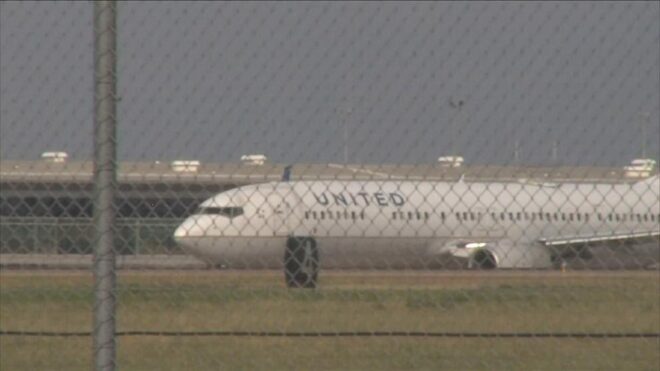
A United Airlines flight en route from Cancun, Mexico, to Chicago, Illinois, faced a serious in-flight emergency when it encountered severe turbulence on Wednesday afternoon, prompting the crew to divert to Memphis International Airport in Tennessee. The incident resulted in injuries to seven passengers, with one individual requiring hospitalization, while others reported minor injuries.
Flight UA1196, a Boeing 737-900, had departed from Cancun International Airport with 172 passengers and seven crew members on board. The flight had been progressing smoothly until it encountered what was described as a “brief but severe” episode of turbulence while flying over Louisiana. The turbulence struck while the aircraft was cruising at high altitude, with the seatbelt sign illuminated, indicating that passengers were advised to remain seated and buckled in. Despite the precautions, the unexpected intensity of the turbulence resulted in injuries to multiple passengers.
The aircraft’s flight crew, following standard operating procedures, promptly decided to divert to the nearest suitable airport to assess the situation and provide medical assistance to those affected. The flight was rerouted to Memphis International Airport, where it made a safe landing at approximately 2:40 p.m. Central Time. Emergency medical teams were already on standby at the airport when the plane touched down.
Upon landing, paramedics from the Memphis Fire Department boarded the aircraft to evaluate the condition of the passengers. One person was found to have non-critical injuries and was transported to a local hospital for further treatment. The other six passengers who reported injuries declined additional medical assistance at the airport, choosing not to be transported to a medical facility. The exact nature of their injuries has not been disclosed, but authorities noted that they were minor and did not necessitate hospitalization.
United Airlines quickly released a statement expressing gratitude for the actions of the flight crew, whose efforts ensured the safety of all passengers and crew members during the incident. “We’re grateful to our crew for their efforts to ensure the safety of our employees and customers,” the airline said. The company did not specify the severity of the turbulence but acknowledged that it had been significant enough to necessitate a diversion.
Following the incident, the Federal Aviation Administration (FAA) announced that it would be conducting a thorough investigation into the cause of the turbulence. The FAA regularly investigates incidents of this nature to determine whether any factors, such as weather conditions or air traffic control communications, may have contributed to the event. According to initial reports, the turbulence was encountered during normal cruising conditions, and no other aircraft in the vicinity reported similar issues at the time.
The FAA will likely review weather data, radar readings, and air traffic communications to establish a timeline of events. Investigators may also examine whether turbulence warnings had been issued prior to the incident and if the flight crew had sufficient information to prepare for potentially turbulent conditions.
Once medical evaluations were completed and the situation was deemed stable, Flight UA1196 resumed its journey to Chicago. The Boeing 737-900 took off from Memphis International Airport later that evening, with passengers expressing relief and gratitude for the safe handling of the situation by the flight crew. The plane landed at Chicago O’Hare International Airport without further incident, concluding a challenging journey that left many passengers shaken but otherwise unharmed.
Turbulence is a common occurrence during air travel, particularly when flying over areas known for atmospheric instability, such as mountainous regions or during thunderstorms. It results from sudden changes in airflow, which can be caused by factors including jet streams, weather fronts, and thermal convection. In most cases, turbulence is mild and considered more of an inconvenience than a safety risk. However, on rare occasions, it can become severe and cause injuries, especially if passengers are not wearing their seatbelts.
The aviation industry has seen improvements in technology that help predict turbulence more accurately. Pilots rely on reports from other aircraft, radar readings, and turbulence detection systems to avoid areas of instability. Additionally, flight attendants remind passengers to keep their seatbelts fastened even when the seatbelt sign is turned off, a precaution that can significantly reduce the risk of injuries in unexpected turbulence.
Several passengers on board Flight UA1196 shared their experiences following the incident, describing the sudden onset of turbulence as “jarring” and “unsettling.” One passenger recounted how the plane seemed to “drop suddenly,” causing unsecured items to be thrown about the cabin. “It felt like we hit a wall of air that just pushed the plane up and then dropped it,” said the passenger, who was seated near the middle of the aircraft. “Everyone was holding on to their armrests, and you could hear people gasping.”
Another traveler praised the flight crew for their calm and professional handling of the situation, saying that the captain kept passengers informed and reassured them that the diversion to Memphis was a precautionary measure. “They really did a great job keeping everyone calm. I’m just glad no one was seriously hurt,” the passenger added.
The incident serves as a reminder of the importance of following in-flight safety protocols, particularly keeping seatbelts fastened whenever seated. While turbulence-related injuries are relatively rare, they do happen, often when passengers are standing or moving about the cabin during unexpected turbulence. The Federal Aviation Administration recommends that passengers keep their seatbelts fastened at all times during the flight, even when the seatbelt sign is off, to reduce the risk of injury.
In light of incidents like this, airlines and regulatory bodies may explore additional safety measures to better protect passengers during turbulence. These could include advanced turbulence prediction technology, real-time updates from other aircraft, and enhancements to cabin design that minimize the movement of loose items. Training for crew members is also continually evolving to better prepare them for